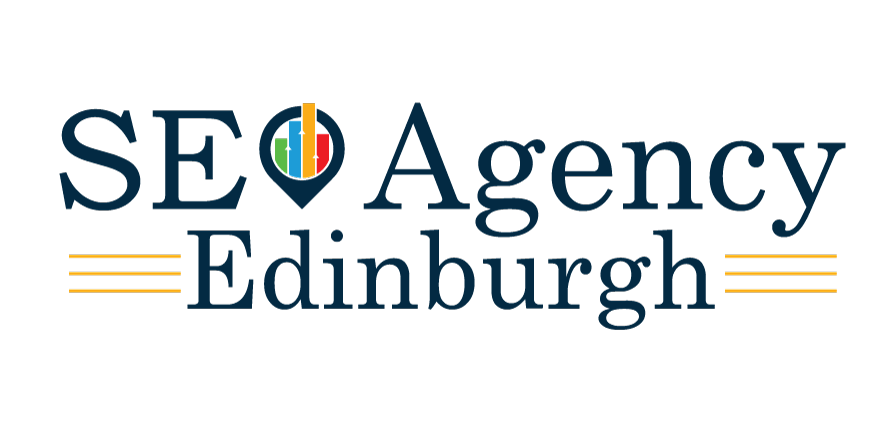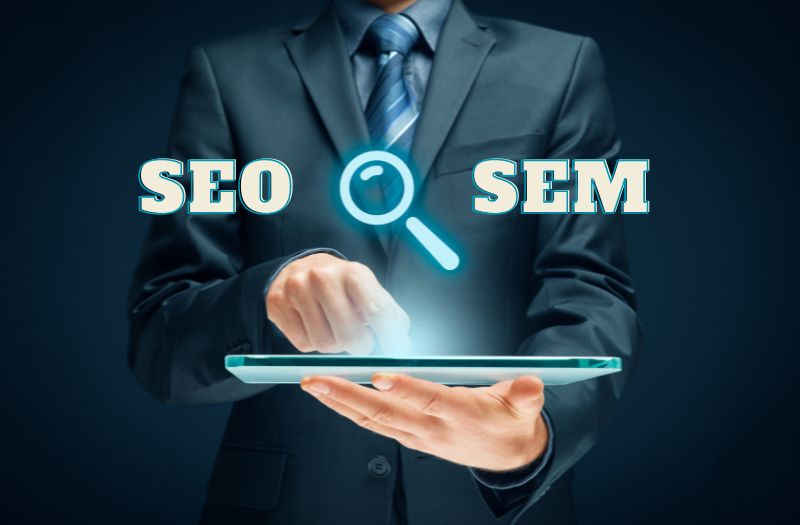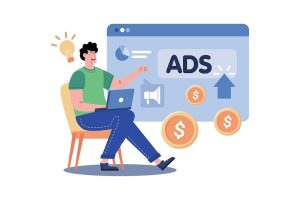It is understandable that there are many phrases that are used to refer to our outreach endeavors, given the huge role that search engines play in attracting new customers. Although there is general agreement that SEO is the process to drive organic traffic to a website through higher search engine rankings, there is still some debate on how to define paid efforts. Confusion might come along, but the same way that social media has organic and paid elements, search engine traffic does too.
Search engine marketing consists of two main components: Organic SEO and Paid Search (PPC, or Pay Per Click campaigns). This mirrors the two components of social media marketing: organic and paid. Therefore, it is essential to understand both aspects of search engine marketing in order to maximize visibility and reach your desired goals. Many people think of the various marketing modalities, like sponsored results and races for the Snippet box, as a comparison between SEO Vs SEM.
How do they both differ? Search Engine Marketing (SEM) is often incorrectly referred to as Pay-Per-Click (PPC). However, a better way to look at it is Organic Search (SEO) plus Paid Search (PPC). That way, it is easier to differentiate between the two and avoid any confusion. In the same way that we initially only thought of social media marketing as organic, search engine marketing was priorly only seen as a paid effort. The term “marketing” should refer to both organic and paid strategies. Let’s get deep with the terms now.
What is SEO?
SEO (Search Engine Optimization) is the process of optimizing your website to improve its rankings in search engine results. This involves both internal and external optimization, such as optimizing your website’s content and coding to make it more attractive to search engine algorithms. By improving your website’s organic visibility, you can increase the chances of your content appearing higher up in search engine results. To ensure a successful SEO program, it is essential to conduct thorough keyword research and craft quality content that meets the needs of your target customers’ search intent. There are a variety of strategies available to achieve this goal.
What is Paid Search?
Paid search is similar to SEO, but instead of relying on organic methods to bring content to the top of search engine results, it involves paying search engines for the content to be displayed prominently in the search engine results. If you take a glance at the typical search engine result page (SERP), you will observe “sponsored” outcomes. Moreover, there are text advertisements located on the side of the majority of search pages. Paid search incorporates both SEO and SEM as two different yet related techniques.
While SEO focuses on optimizing a website’s content with keywords, SEM involves paying for advertisements on search engine results pages. Although they both use keywords, they are distinct strategies that work together to help improve a website’s visibility and ranking in search engine results.
What Types of SEO Exist?
It is evident that SEO is a quickly evolving field and achieving quality results can require a combination of tactics. This is especially true since SEO is becoming more and more competitive, with many of the regulations altering with time.
1. On-Page SEO
On-page SEO is the practice of using content creation methods to make your page more attractive to search engines. This includes carefully selecting keywords, headings, and descriptions for your page. Utilizing SEO tools can help you to identify the right keywords to use and the frequency at which they should be included in your text. In short, on-page SEO is an important part of a successful SEO vs SEM campaign. To optimize your website’s on-page SEO, you should include images and other media. If done correctly, these elements can be indexed by search engines, helping to improve your ranking.
Additionally, you should add meta descriptions and ADA-compliant text to further increase your SEO results. Finally, internal links are a key component of on-page SEO. This is because search engines such as Google take into account the amount of time users spend on a website when ranking content. By providing internal links, readers are able to navigate to other relevant pages on the website, thus increasing the overall time on site.
2. Off-Page SEO
The objective of off-page SEO is to increase the credibility of an entire website by creating links between different sites. An excellent way to achieve this is by publishing guest posts on blogs. For instance, if you have been following my website for a while, you will be able to see numerous guest articles.
Moreover, I also provide my assistance to other website owners by writing guest posts for their sites. Crediting high-quality sources is an excellent way to get quality links. As the adage goes, it is important to recognize the accomplishments of others. When you link back to the content pages of authoritative sites, this can demonstrate to others that you are an expert on the matter, which can result in them linking back to you. This can lead to higher search engine rankings and even mutual linkbacks.
3. Technical SEO
Ensuring that your website is optimized for technical SEO is essential for achieving a spot on page 1. This includes making sure that the site runs smoothly for each visitor; for example, the page should always load with the speed of the blink of an eye. In order to ensure that your site is accessible to all users, no matter what device they are using, it is important to make sure it is mobile-friendly. This can be done by creating a mobile edition of the site or by optimizing the existing site for mobile devices. Regardless of the strategy chosen, it is essential that search engines can easily crawl and index your site.
What Types of Paid Search Exist?
Paid search is the second half of the SEO vs SEM equation. In short, it involves paying Google or another search engine to display your advertisement or content when a user searches for specific keywords or visits related sites. When selecting keywords for your Search Engine Marketing (SEM) campaigns, it is essential to utilize the same tactics you would for Search Engine Optimization (SEO). This can be beneficial when you do not have a place on the first page of search results. According to Google, there are several different types to consider:
1. Search Ads
AdWords and paid search results are among the oldest types of advertising on Google, as well as other search engines. A key aspect of these search ads is that they are text-only and do not offer much scope for creativity.
2. Display Ads
A Display Ad is a picture, video, or combination of both, with accompanying text, that is tailored to a customer’s browsing history. For example, if someone is a marketing professional, they see display ads for any and all marketing-related products and services. Display ads can range from a large popup or banner ad to a small icon on the side or bottom of a page, and I may see them on my personal devices when I’m looking for something to do in my free time.
3. Shopping Ads
An advertisement featuring a product related to the keyword being searched is known as a shopping ad. These ads typically appear at the top of search engine results pages (SERPs). The product advertised can be the exact keyword, or something else. Shopping ads are typically used by e-commerce businesses and retailers.
4. Gmail Ads
Gmail ads enable organizations to reach a tailored audience with sponsored emails. For example, a college may send a promotional email to individuals who have a higher education, or those who are looking to pursue one. These emails are placed in the social media and promotions folder, rather than the primary folder, and are clearly labeled as an advertisement.
5. Youtube Ads
YouTube ads are videos that are played before and during content that a YouTube user desires to see. There are two methods for having your ad selected for a video: general audiences or based on Google’s knowledge of the consumer. Viewers have to watch the first 5 sec of the ad, but they can touch to skip the remaining.
What’s include in Paid Search Campaigns?
In order to effectively manage both SEO and SEM campaigns, careful consideration must be given to the content, pricing, and audiences reached. Additionally, there are various types of SEO that require proper management, as well as features of paid search platforms that must be managed in order to maximize the success of the campaign.
a. Bidding
SEO and SEM are two different strategies for increasing website visibility and traffic. With SEO, you focus on optimizing your website content and structure for search engine algorithms, while with SEM you pay for ad space on search engines like Google or Bing. SEM involves bidding on keywords and phrases to appear in search engine results and paying for these impressions or conversions. This is done to maximize return on investment, as you can target your ads to users who are most likely to convert.
b. Quality Score
A Quality Score is an evaluation of how relevant an advertisement is to its target audience, as determined by Google. The higher your score is, the more cost-effective it will be to bid on auctions. In other words, it is an indication of the quality of your ad.
c. Creative
Creating high-quality advertisements is essential for success. The way content is presented can be a deciding factor for many people when choosing which ads to click. If someone is looking to purchase a product or service from their local market, they should be aware of any signs of poor language proficiency, as this could be an indication they should avoid the ad.
d. Keywords
To ensure your SEO and SEM efforts are successful, it’s important to choose the right keywords. Select keywords that are relevant to your product, and if budget is a concern, opt for less competitive variants. Utilizing a quality marketing tool can help you identify these keywords.
e. Demographic Targeting
When selecting a target demographic, it is important to consider the type of product or service you are offering. For instance, adults aged 25-40 is a usual option, but you may want to target a different age range depending on the nature of your business. Additionally, if your products or services are gender-specific, you should consider whether targeting one gender is the best course of action. Ultimately, the choice of target demographic should be tailored to the individual business.
When to Focus on Paid Search?
In certain cases, paid search is more beneficial than SEO for achieving consistent traffic, such as when attempting to build domain authority. While SEO provides a more organic way to increase website visibility, paid search offers a more immediate and controllable solution. Even if you are late to the game, the best way to get competitive search results is to pay for them until you can build domain authority, which needs time. In essence, Google puts so much weight on domain authority that you have no choice but to pay for top-notch results initially.
When it comes to investing in strategic sales and lead generation campaigns, SEM is essential. Not only does it help your content get found, but it can also generate a high return on investment. Paid search is particularly valuable when you need to shape your overall strategy, as it can provide invaluable insights. Paid search is an excellent way to immediately create brand awareness. With careful use of branded search terms, you can ensure that your brand appears at the top of search results. Additionally, paid search can be used to help your brand stand out when people search for your competitors, giving you the chance to take away some of the spotlight.
When to Focus on Organic Search?
It is clear that SEO is the preferable choice in certain circumstances. For example, when there is no budget available for advertising, then optimizing the on-page elements of a website is essential. Thus, in the SEO vs SEM debate, SEO wins out in most scenarios. Focusing on organic search is an important part of any website’s success. It enables you to target users who are looking for more than just the products or services you offer.
Even if you are in the early stages of building your website, investing in creating content that can be found in organic search is essential for long-term success. SEO is an essential factor for businesses with large SEM budgets. By investing in high-quality SEO strategies, you can reduce your reliance on expensive Paid Search campaigns and still maintain a steady stream of website visitors. To ensure that your website remains viable in the long run, it is essential to build a strong presence and reputation in your chosen field.
Why Should You Focus on Both?
At the conclusion of this discussion, it is clear that neither SEO nor SEM is the ultimate solution to boosting content. Rather, a well-thought-out digital strategy that effectively leverages both methods together is the most effective way to ensure your content and advertisements will have a mutually beneficial relationship. If you cannot rank organically for all of the strategic keywords you are targeting, and though in some cases you would, you would likely still be below ads in the search results, you should consider using paid search to compete for those keywords. This can help ensure that your website is not overshadowed by the competition. It is wise to stick to strategies that are yielding positive results.
For example, if paid search is providing a high return on investment, continuing to invest in it is a no-brainer; you are bringing in profit from each advertisement! As the old adage goes, if something is not broken, don’t try to fix it. SEO is an incredibly effective way to increase website visits and sales, leading to high returns on investment in the long term. Although you don’t have to pay a platform like Google to be part of it, forming and sustaining a solid SEO plan does require money for research and content production. Paid search is an effective, potentially profitable strategy in the short term.
However, it is important to remember that your ultimate goal should be to increase your website domain authority and increase organic search traffic in the long run. Striking a balance between short-term and long-term strategies can be challenging, but it is worth the effort. Utilizing analytics and having a well-thought-out plan can help you make the most of your efforts.








